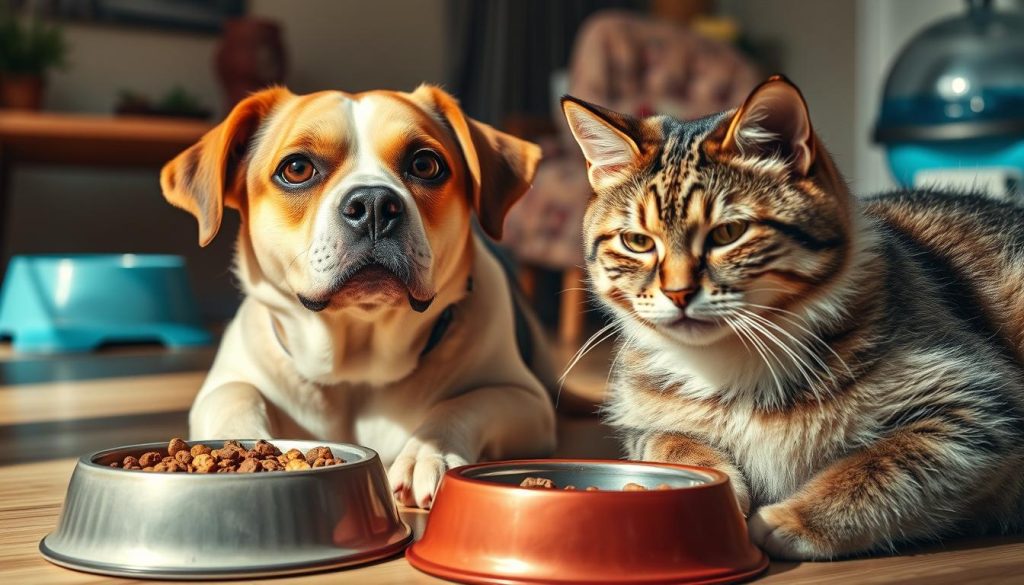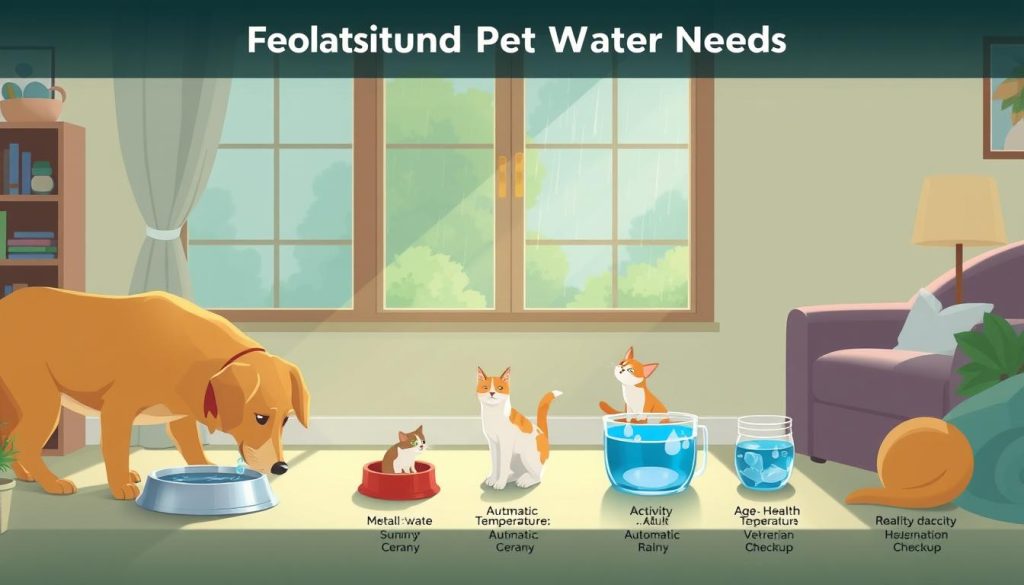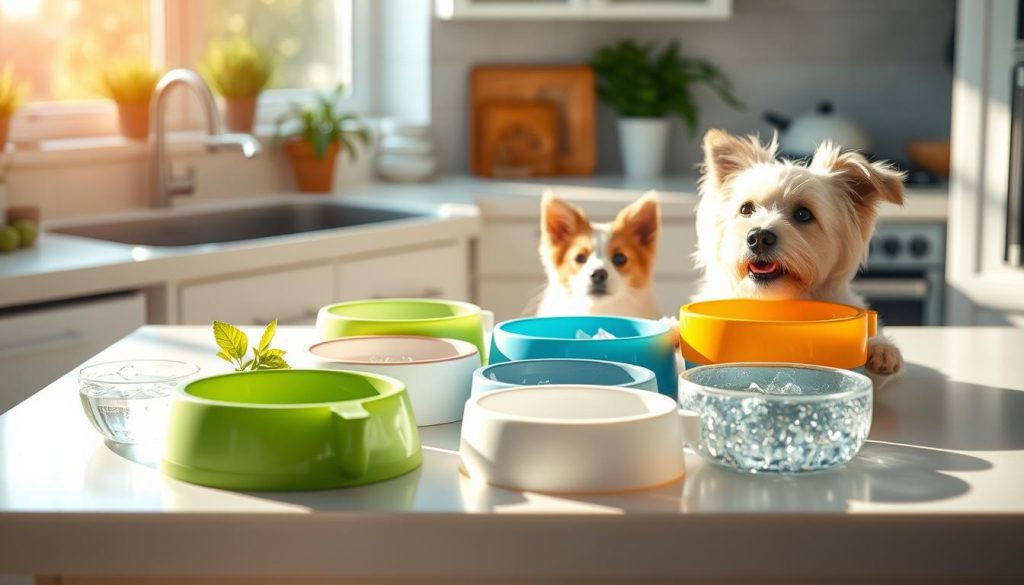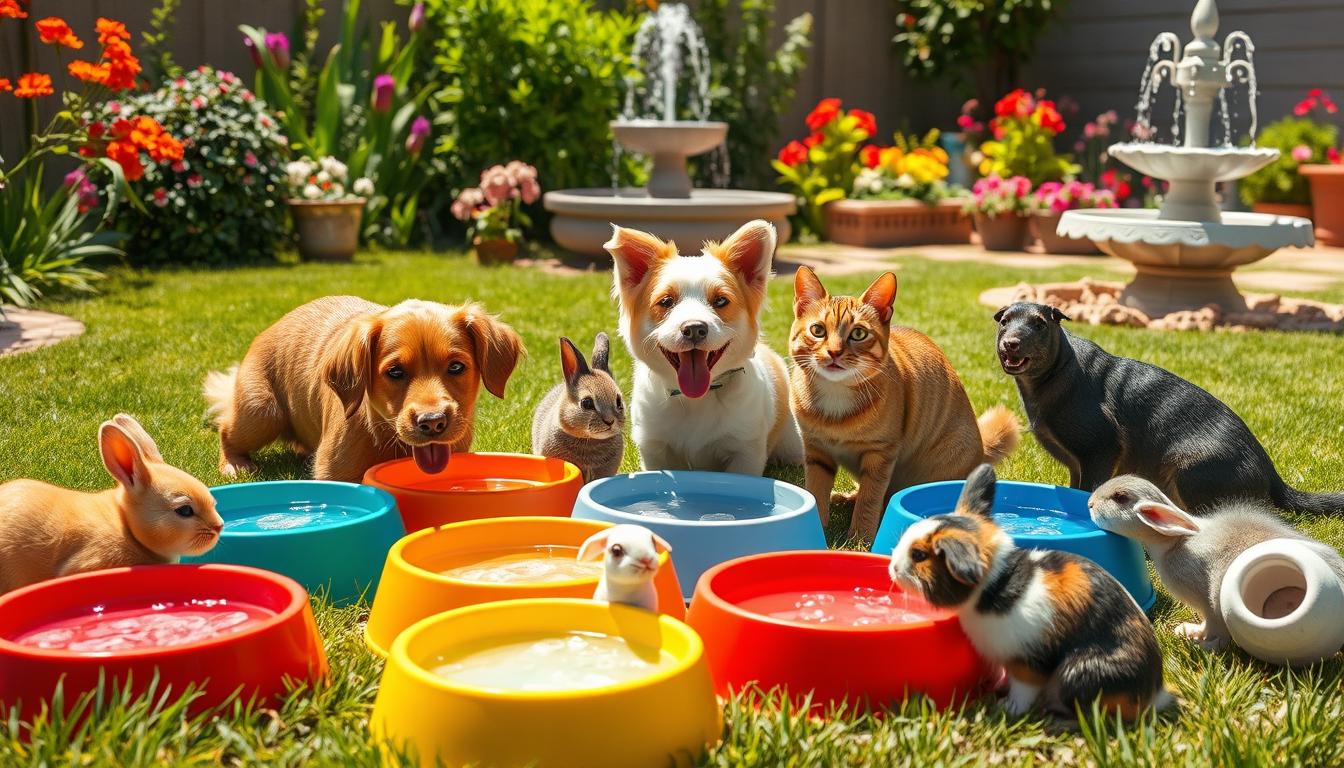As a pet parent, making sure your furry friend drinks enough water is key to their health. In this guide, we’ll dive into why pet hydration matters, how to spot dehydration, and how much water pets need. We’ll also share fun ways to get them to drink more. By the end, you’ll know how to keep your pet happy, healthy, and well-hydrated, all year round.
The Importance of Proper Pet Hydration
Why Water Matters for Your Furry Friend
Keeping your pet hydrated is key for their health. Water helps control their body temperature, aids digestion, and supports organs. It also prevents urinary issues, reduces heatstroke risk, and keeps skin and coat healthy.
Water is vital for your pet’s body to work well. It carries nutrients, removes toxins, and keeps organs functioning. Without enough water, pets can get dehydrated, leading to health problems.
Proper hydration offers many benefits for pets. It boosts energy, supports the immune system, and makes their coat shiny. By providing clean, fresh water, you help keep your pet healthy.
The role of water in pet health is huge. By focusing on hydration, you keep your pet comfortable and prevent serious health issues. Monitoring your pet’s water intake is a simple way to support their health for years to come.
Signs Your Pet May Be Dehydrated

It’s important to know the signs of pet dehydration to keep your pet healthy. As pet owners, we must watch for dehydration signs. This ensures our pets stay hydrated. Here are some common symptoms of dehydration in pets to look out for:
- Dry or sticky gums
- Lethargy and decreased energy levels
- Sunken eyes
- Reduced skin elasticity (the skin takes longer to return to its normal position when gently pinched)
- Decreased urine output or dark yellow urine
If you see any of these signs of pet dehydration, act fast. Dehydration can cause serious health problems if not treated. It’s key to spot the signs of dehydration in pets and fix it quickly.
| Symptom | Description |
|---|---|
| Dry or Sticky Gums | Healthy gums should be moist and slick. Dehydrated pets will have dry, tacky gums. |
| Lethargy | Dehydrated pets will appear tired, sluggish, and less energetic than usual. |
| Sunken Eyes | The eyes of a dehydrated pet will appear sunken into the head. |
| Decreased Skin Elasticity | Gently pinch the skin on your pet’s back. It should snap back quickly. Dehydrated pets will have slower skin return. |
| Reduced Urine Output | Dehydrated pets will urinate less frequently and their urine may appear darker in color. |
Knowing these signs of pet dehydration helps you keep your pet hydrated and healthy. If you’re worried, talk to your vet for advice.
How Much Water Does My Pet Need?

Keeping your pet hydrated is key for their health. But, how much water they need can change based on several things. Knowing what affects their water needs helps you keep them happy and hydrated.
Calculating Your Pet’s Daily Water Intake
Dogs should drink about 1 ounce of water for every pound of their body weight each day. Cats need about half to one ounce of water for every pound. But, these are just starting points. Your pet’s actual needs can vary a lot.
| Pet Type | Recommended Daily Water Intake |
|---|---|
| Dogs | 1 ounce per pound of body weight |
| Cats | 1/2 to 1 ounce per pound of body weight |
It’s smart to talk to your vet to figure out the best water intake for your pet. Things like their age, size, how active they are, and where they live can all play a part. Keeping your pet hydrated is important for their health and happiness.
Remember, the amount of water your pet needs is just a starting point. Watch how much they drink and look for signs of dehydration. Adjust their water intake as needed. With the right amount of water, your pet will stay happy, healthy, and full of energy all day long.
Pet Hydration: Keeping Water Bowls Fresh and Clean

Keeping your pet’s water bowls clean is key to their health. Regular cleaning and managing water well helps keep them hydrated and healthy.
Start by washing your pet’s water bowls with soap and water every day. This removes dirt, debris, and bacteria, giving your pet clean water. Also, always replace the water to avoid harmful bacteria growth.
Think about getting a pet water dispenser or fountain. They keep water cool and oxygenated. They also make your pet drink more, keeping them hydrated all day.
| Task | Frequency |
|---|---|
| Wash water bowls with soap and water | Daily |
| Replace water in bowls | Daily |
| Clean and refill water dispensers/fountains | Weekly |
By keeping pet water bowls clean and fresh, you help your pet stay hydrated and healthy. Remember, keeping them hydrated is crucial for their well-being. Make it a part of your daily pet care routine.
Creative Ways to Encourage Water Consumption
Making Hydration Fun for Your Pet
Keeping your pet hydrated is key for their health. If they don’t drink enough, there are fun ways to make water more appealing. Engaging their senses and making it a positive experience can help.
Try adding low-sodium broth or pureed fruit to their water. This can make it more tempting for them to drink. You can also freeze treats or bits of their favorite food in ice cubes. This makes drinking water a fun and refreshing activity.
If your pet likes running water, a pet water fountain is a great idea. It makes water more appealing and increases their intake. The flow and sounds can capture their interest. Just remember to clean it often to keep the water fresh.
The main goal is to find ways to make drinking water fun for your pet. By doing so, you ensure they stay hydrated and healthy.
Staying Hydrated on the Go
Keeping your pet hydrated is key when you’re out and about. This includes road trips, hikes, or days at the park. Make sure to pack a portable water bowl and lots of fresh water. A collapsible or travel-friendly water dish is a great idea to make hydration easy wherever you are.
When hydrating pets during travel, remember that temperature and activity level matter. In hot weather or when your pet is active, they’ll need more water breaks. Carry a strong, spill-proof water container and a portable pet water solution for clean, fresh water on your adventures.
- Pack a collapsible or travel-friendly water bowl for easy pet hydration during activities
- Bring a sturdy, spill-proof water container to keep your pet hydrated on the go
- Offer water breaks more frequently during hot weather or periods of increased physical activity
By planning ahead and focusing on hydrating pets during travel, you can keep your furry friend happy, healthy, and hydrated. No matter where your journey goes, your pet will be well taken care of.
| Product | Description | Price |
|---|---|---|
| Collapsible Pet Water Bowl | A lightweight, portable water dish that folds flat for easy storage and transportation. | $9.99 |
| Insulated Water Bottle with Bowl | A dual-purpose bottle that keeps water cool and includes a built-in, detachable bowl for your pet. | $14.99 |
| Paw-Activated Water Dispenser | A hands-free, pet-operated water dispenser that provides a continuous supply of fresh water. | $19.99 |
When to Seek Veterinary Assistance
Keeping your pet hydrated is key to their health. But, sometimes dehydration can mean there’s a bigger health issue. If your pet seems very tired, has sunken eyes, or a dry mouth, you should see a vet.
Dehydration can point to problems like kidney disease, diabetes, or stomach issues. A vet can check your pet, do tests, and find out why they’re dehydrated. This helps make sure your pet gets the right care and gets better fast.
If your pet isn’t drinking enough water or can’t stay hydrated, even with help, get vet advice. Your vet can give you specific advice to help your pet stay healthy.

